#if i like you and you died prior to canon (in a posthumous-character “exists in flashbacks/old recordings” way) ill rez you though
Text
that really is basically how i determine my selfship timelines for series where a lot of characters die. like are you on any section of The List? you get to live. do i like you even if i don't consider you a f/o in any form? you get to live. do i think the one-off bit you were created for is funny? you get to live. do i not like you? damn sucks that you died get better soon i wont do anything about it though
#i wont kill anyone who's not canonically dead but i sure as hell wont rewrite canon to resurrect someone i hate#if i like you and you died prior to canon (in a posthumous-character “exists in flashbacks/old recordings” way) ill rez you though
7 notes
·
View notes
Text
Mary and butterflies - the inevitability of death, murderous calling cards and collectors
Some ramblings with links to other people’s excellent meta, in which I suggest that butterflies (and/or moths) symbolize Mary as Moriarty’s reincarnation and or calling card, while also hint at her inevitable death.
Disclaimers: credits are below the cut. I’m not an expert in any of these topics. Thank you, @thewatsonbeekeepers for the beta. In this post I’ll be using moths and butterflies interchangeably, apologies to any entomologists.
Mary’s appearance in the show brings with it new imagery we haven’t seen prior to The Empty Hearse - butterflies. Once Mary’s in the picture, there are butterflies in some very strategic locations, all are either visually or subtextually leading to her. The show has done that previous to season 3; Moriarty is connected to some well established symbols like magpies, apples and IOUs.
When I first started reading meta I used to think these themes were a bit of a stretch, but I’ve since accepted that this is a show that puts barely noticeable phoenixes in a restaurant scene that shows us Sherlock rising from his death.
Here are some of the butterflies I spotted so far:

Butterflies (and in the case of this piece of meta, moth) symbolize most commonly resurrection, change and renewal. Behind the symbolism stands the transformation of a small, ungainly creature into something full-grown and unbound. In that case, in the simplest way, one could argue that butterflies were chosen to symbolize her because the ‘Mary Morstan’ persona was a stillborn’s identity that was stolen and used ‘reborn’ to create a new person.
But more than this simplistic idea; butterflies carry multiple symbolisms. When it comes to Sherlock, I and many others tend to look at Victorian symbolism, considering the detective’s Victorian roots.
I find the appearance of butterflies interesting in Mary’s context, much like I find the skull interesting in Sherlock’s. The skulls, in Sherlock’s case, serve plenty of purposes, but one of them is the idea of memento mori.
Memento mori (Latin for 'remember that you [have to] die') is an artistic or symbolic reminder of the inevitability of death. These are representations that can appear in any form of art such as paintings, literature, poetry etc. It’s a concept that existed in many ancient cultures but is also deeply rooted in early Christianity. It serves to remind people of the inevitable; that even if we choose to ignore it, not think about it, it’s always there lurking, and the purpose is not to scare us but to encourage us to make good use of our time when we’re alive.
Memento mori was the philosophy of reflecting on your own death as a form of spiritual improvement, and rejecting earthly vanities.
Victorians were obsessed with the concept (weren’t Victorians obsessed with everything?). They would take photographs of the dead and keep locks of hair of those who died in mourning brooches. It is said that they found these practices comforting.
Another expression of the ‘remember that you must die’ concept was vanitas art; vanitas is a symbolic work of art showing the transience of life, the futility of pleasure, and the certainty of death. The Latin noun vanitas (from the Latin adjective vanus 'empty') means 'emptiness', 'futility', or 'worthlessness', the traditional Christian view being that earthly goods and pursuits are transient and worthless. It alludes to Ecclesiastes 1:2; 12:8, where vanitas translates the Hebrew word hevel (הבל), which also includes the concept of transitoriness.
This concept reminds me, most especially, of the skull used in The Abominable Bride, which is actually Charles Allen Gilbert's 'All is Vanity' Illusion art.
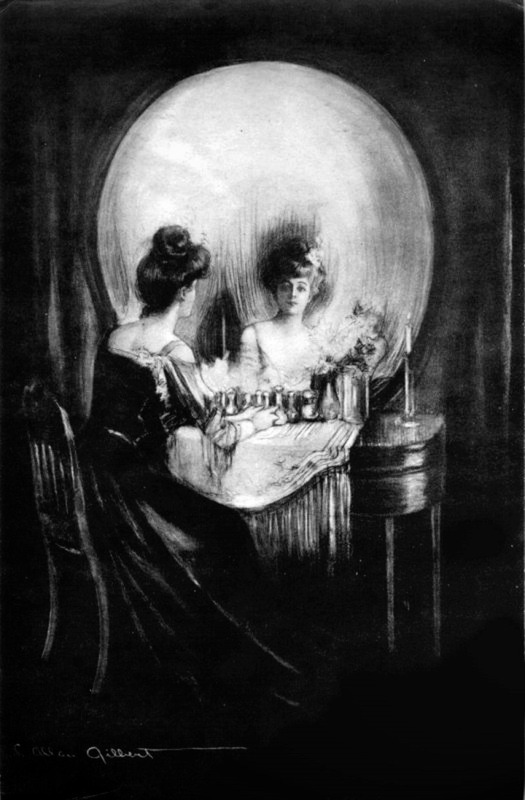
Back to butterflies - butterflies are a staple component of vanitas art - paintings executed in the vanitas style were meant to remind viewers of the transience of life, the futility of pleasure, and the certainty of death. They also provided a moral justification for painting attractive objects - in a way, it’s a justification for the vanity, or the human need of enjoyment of beautiful things. Below is a vanitas by Jan Sanders van Hemessen:

But butterflies are also considered an omen of death:
“Butterflies and moths were associated with death, sometimes merely as omens, sometimes as the soul or ghost.” These butterfly omens came in many ways. For example, in the nineteenth century United States, some people thought that a trio of butterflies was an omen of death.” [x]
Oh.

But I also think there’s more to the butterfly symbolism than Mary’s imminent death; I suggest that, in keeping with @loudest-subtext-in-tv M-Theory (suggesting that Mary was planted in John’s life by Moriarty), they symbolize Mary as Moriarty reincarnated following his death in TRF. That Moriarty had indeed not disappointed Sherlock - there was a posthumous game after all! That Sherlock was supposed to understand that while one form of Moriarty died on that roof, another had emerged, continuing the mission of burning Sherlock’s heart. Mary is Moriarty’s calling card, left behind in the crime scene. They’re different, but not separate, which is why Sherlock is so obsessed with Moriarty between HLV-T6T; he’s both wrong and correct at the same time.
So far, what I’ve suggested is that in Sherlock, skulls are Sherlock’s symbolic memento mori - the skulls are associated with Sherlock in some very significant ways.
However, Mary’s character was doomed from the start - she dies during Sherlock’s hiatus in ACD canon. I believe many fans assumed Sherlock’s Mary expected the same fate when she was introduced to the show. Although the story of Samarra is told by Sherlock, who expects his own death in T6T, Mary is the one who ends up dying.
Butterflies in ACD canon
Searching for the significance of butterflies in the ACD and BBC canon led me to a number of interesting directions in meta written by others.
The first and probably the best place to start is this meta post by @tendergingergirl, which I strongly suggest you read in full: Butterflies, Sexual Deviancy & The Bloodline Theory in The Hound of The Baskervilles.
Stapleton also has a hobby. He collects bugs…Butterflies, to be exact. This can often be seen as purely academic, but depending on the actions of the hobbyist, they can indicate more disturbing things. That of holding something vulnerable captive, treating it as your hostage, pinning it down. The torture of animals has come to be a good indicator of someone who would do this to a human. He had already shown callousness by laughing as he recounts to Holmes of ponies wandering onto the Moor, becoming trapped, and dying. In 1974, there was a release of a new edition of Sherlock Holmes stories, with the forward of The Hound of The Baskervilles written by British author, John Fowles. He is responsible for several well-known works, including The French Lieutenant’s Wife. Another, was a novel that Mason finds himself wondering why Fowles doesn’t mention in his introduction, since the villain is such a close parallel to Stapleton.(but as we have learned through the study of ACD, most writers will not come right out and say where they got their inspiration. They like for you to guess!)
A lonely young man, works as a clerk, and collects butterflies, becomes obsessed with a pretty young girl, Miranda, an art student. He chloroforms, and kidnaps her, taking her to his cellar basement, to add Miranda to his collection. That book was called The Collector. But what else does it sound like?
“So yes, I googled. From an article on the release of the movie’s Documentary. "The docu proves a poor reference point for anyone who wants to understand the literary and movie links for “Lambs.” There’s no mention, for example, of how Harris partly based the butterfly-loving Bill on John Fowles’ kidnapper in “The Collector” …And here I thought Mofftiss added allusions to Silence of The Lambs into Sherlock just for fun. SMH.”
@tendergingergirl also added this photo to their post:
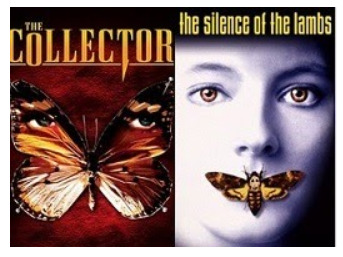
So what we have here is a chain of metatextualities/inspiration, starting with ACD’s THOB, where Jack Stapelton inspires a book about a disturbed butterfly collector (The Collector by John Fowles), which inspires a the author of Silence of the Lambs in creation of his character Buffalo Bill, a serial murderer who inserts a death's head moth into the victim's throat because he is fascinated by the insect's metamorphosis. Silence of the Lambs served as inspiration for Sherlock as analyzed by @garkgatiss in Bond, Hannibal, and Holmes (I suggest you read the whole Hannibal section) .
Let’s look again at some imagery from His Last Vow. Mary shoots Sherlock’s heart, essentially burning his heart out, and who does Sherlock meet in his Mind Palace in a very cocoon-like straightjacket? Yes, the dead dude who encourages him to die already (“one more push, and off you pop”).
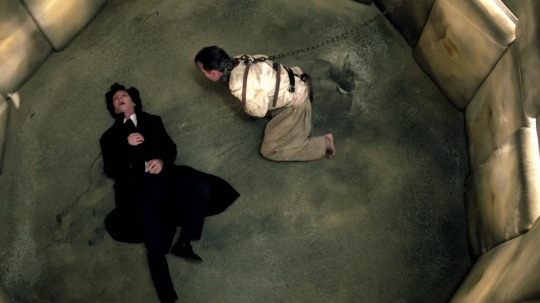
What’s the next thing we as an audience see once Sherlock opens his eyes? Mary coming to the hospital to hear that Sherlock had, in fact, survived. And what is she wearing? Her butterfly scarf, one which will another appearance later in the episode, during the tarmac scene.
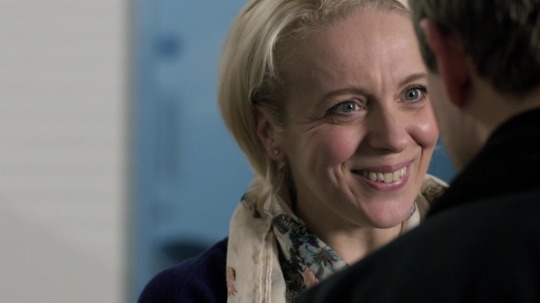
I also find it interesting that in the context of Sherlock and Silence of the Lamb, there’s an element of gender-switching between Moriarty and Mary. Buffalo Bill, the murderer from Silence of the Lambs, skins bodies of women to create himself a woman’s 'suit’; in Sherlock, Moriarty is a man-villain who transforms into a female-villain in the form of a bride and/or Mary.
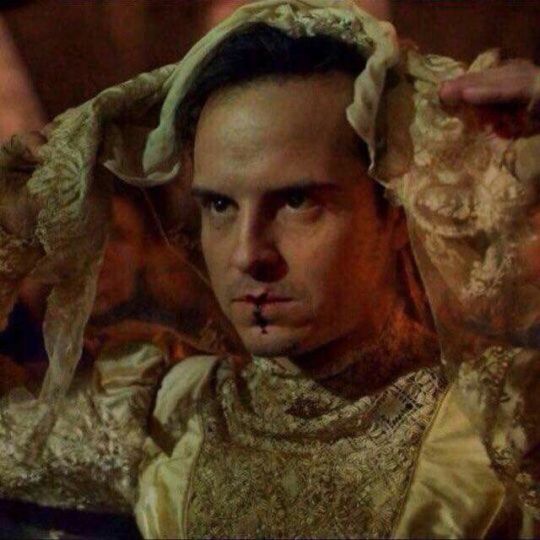
By the way, who else is obsessed with his suits?

Also, let’s not forget the worms, maggots and other such crawlers in the grave scene:

Now, let’s go over some of the photos I included in the beginning of this post a bit further.

Mrs. Hudson’s butterfly tea set is first shown in TEH - she uses it to serve John tea when he comes visiting her and tellis her about Mary. We also see it near John’s chair on the day of the wedding. This isn’t Sherlock’s set - his set is different, featuring the British Isles. Moriarty drinks from it in TRF. The next tea set we see, now that Moriarty is dead, is the butterflies one. In TLD, Mrs. Hudson uses Sherlock’s tea set - the butterflies are gone.

Mary’s bedroom wallpaper is very feminine, with flowers and butterflies, both complementing symbols while also very common in vanitas art. Much like Mrs. Hudson’s wallpaper in Baker Street, Mary’s wallpaper is supposed to show the contrast between Mary’s flat/Mary and Sherlock’s flat/Sherlock.

There’s an interesting moth reference in The Empty Hearse, which in my opinion, is Mary & Moriarty related. In short, in a previous piece of meta I wrote, I suggested that the Jack the Ripper case in TEH is subtext alluding to Mary’s skeletons, which Sherlock ignores because he’s upset by his reception by John. And what’s one of the first things Sherlock notices about the skeleton? New mothballs smell, hinting at an attempt to get rid of moth/butterflies - maybe a hint to the fact that Sherlock has a chance to discover the truth about Mary but misses it. Also, in the context of Mary and the Jack the Ripper case, notice this transition:
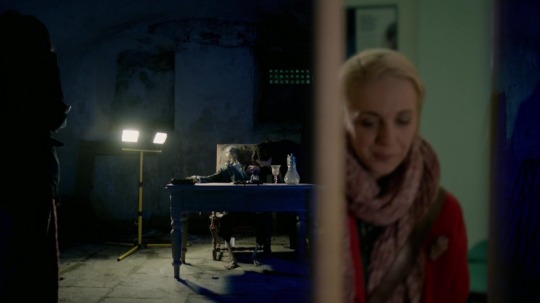
Transitions are important on Sherlock - they’re nearly always there to draw our attention.

This, I think, is perhaps the most telling about a possible connection between Mary and Moriarty: we have both magpies (a Moriarty hint) and butterflies together here. This isn’t the only hint of Mary’s past we get in the wedding; there is, after all, the telegram from CAM.

Mary’s scarf is colorful, and it appears by the time Sherlock’s subconscious suspects Mary. Mary’s black butterfly dress - an ominous dress, I’d say - is the one she wears during the labour scene in the car. The third photo is a behind the scenes photo uploaded by Amanda Abbington, although I’m unsure whether this necklace is AA’s or Mary’s (but I couldn’t pass on including this).
Interestingly, the butterflies do not appear in Rosie’s context - either because it’s a telling sign that Mary won’t be with us much longer, or because Rosie is spared being considered a part of the ‘burning Sherlock’s heart’ plan. Sherlock, on the surface, seems to love Rosie and accepts her.
Also, another BTS photograph I came across during my research which I’ve never seen before and ties nicely to the vanity topic is this one (found here):
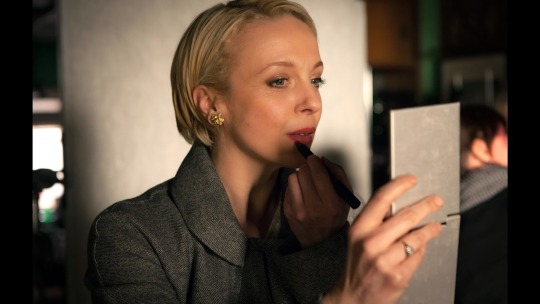
The Death's-head hawkmoth and ‘Death with Interruptions’
You’ll recall that I referenced The Collector and Silence of the Lambs, both featuring butterflies on their cover art.

The Silence of the Lambs cover features Acherontia atropos, otherwise known as the death's-head hawkmoth. It gets its name from the sinister-looking skull shape on its back. In many cultures it is thought to be an omen of death. In a bit of another coincidental but stunning piece of symbolism, all three species of the Death's-head hawkmoth are commonly observed raiding beehives of different species of honey bee; A. atropos only invades colonies of the well-known western honey bee, Apis mellifera, and feeds on both nectar and honey. They can move about in hives without being disturbed because they mimic the scent of the bees and are not recognised as intruders.
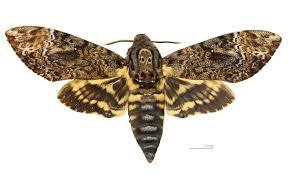
Anyway, the use of Acherontia atropos reminded me of the book ‘Death with Interruptions’ by Jose Saramago. Interestingly, this is another book about a deathly collector with a butterfly on the cover:

In Death with Interruptions death is a woman, and she falls in love with one of her future victims. She decides to spare his life: Every time death sends him his letter [notifying him of his imminent death], it gets returned. death discovers that, without reason, this man has mistakenly not been killed. Although originally intending merely to analyse this man and discover why he is unique, death eventually becomes infatuated with him, so much so that she takes on human form to meet him. Upon visiting the cellist, she plans to personally give him the letter; instead, she falls in love with him, and, by doing so, she becomes even more human-like.
It’s pretty common to read theories about Mary who maybe was one of the assassins due to kill John both at the pool and in front of Barts. So we have a death harbinger trying to kill someone twice and failing. She then falls in love with him.
But how does the butterfly fit in?
Well, at some point in the story, death (that’s her name, sans a capital d), contemplates that using the death head butterfly, instead of a violet piece of paper, would have sent a much stronger message to those whose death is coming for.
And here’s another last bit of coincidental reference to Sherlock: I’d argue shades of purple, among them shades of violet, are associated with Mary and her secrets. There’s the purple dress she wears in TEH, her bridesmaids’ dresses include various shades of purple (including what I would argue was a violet sash) and let’s not forget:
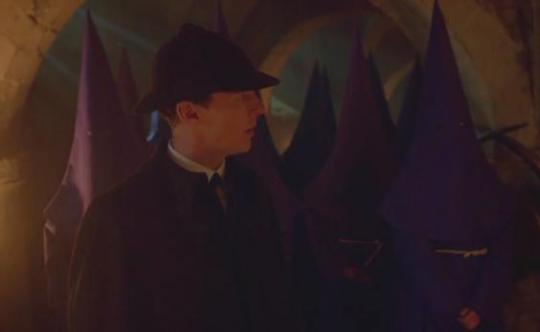
Oh and, by the way, remember the song Donde Estas, Yolanda from TEH, about a woman called Yolanda? Always thought it was a bit of an odd choice for a song?
Yolanda is a female given name, of Greek origin, meaning Violet.
:)
Thoughts?
Credits: thank you @lukessense for directing me to @tendergingergirl meta about butterflies. Episode screenshots are from kissthemgoodbye.net.
@sarahthecoat @tjlcisthenewsexy @devoursjohnlock @inevitably-johnlocked @shylockgnomes @possiblyimbiassed @raggedyblue @ebaeschnbliah @gosherlocked @waitedforgarridebs @helloliriels
#mary mosrtan#butterflies#silence of the lambs#the collector#meta#sherlock meta#tjlc#johnlockendgame#jim moriarty
88 notes
·
View notes
Photo
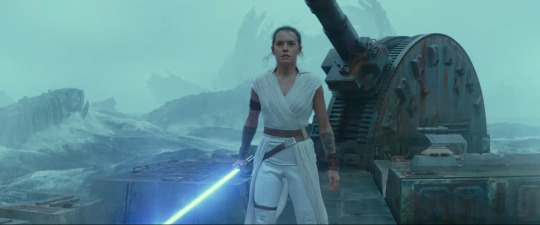
NOTE: This review contains full spoilers.
Star Wars: The Rise of Skywalker (2019)
The ninth installment of the Skywalker saga is not only the conclusion to the Star Wars sequel trilogy, but to a decade where the Walt Disney Company has asserted itself as the most powerful entertainment company that has ever existed. The company, led by Chairman and CEO Bob Iger, is unrecognizable from where it was a decade ago, with Walt Disney Motion Pictures dominating, if not outright monopolizing, theater screens internationally. Unlike the movie moguls of yore such as Darryl F. Zanuck (20th Century Fox), Mack Sennett (Keystone Studios), David O. Selznick (Selznick International), or Jack Warner (Warner Bros.), Iger has a business background, not an artistic one. His respective $4 billion purchases of Lucasfilm and Marvel were decisions not made from cinematic considerations, but financial ones. The conservative artistry seen in Disney’s films in 2019 – including that other enormous blockbuster of the year, Avengers: Endgame – has evidenced where the company’s soul is. This is not the House of Mouse of Walt Disney, which ceased to be in 1968 after the final films Walt produced before his death were released to theaters.
Star Wars: The Rise of Skywalker is directed and co-written by J.J. Abrams (the other co-writer is Chris Terrio), who directed The Force Awakens (2015). The film goes out of its way to repudiate Rian Johnson’s The Last Jedi (2017), which – though valued more than its predecessor by yours truly – unleashed a torrent of intra-fandom acrimony rooted in racism; sexism; and an unhealthy, uncritical merger of personal identity and pop culture franchise. This is not to absolve The Last Jedi of its plentiful shortcomings, but to comment on where the Star Wars fandom is upon the release of The Rise of Skywalker. The Rise of Skywalker is more of a continuation of The Force Awakens, and this includes Abrams’ propensity to craft variations on existing material. Yet even the most creative decisions in this ninth Star Wars episode are hampered by poor filmmaking, two-and-a-half films worth of plot stuffed into one, dreadful writing resulting in thematic inconsistencies and canonical contradictions that will be explained away in some novel or video game, and an obvious lack of planning. The most concerning thing is that Star Wars’ reputation – despite my description of the series four years ago as, “a pastiche and always has been” – as an innovative force in cinema (even the prequels) has been lost. This is not the Star Wars of George Lucas, which ceased to be after Disney’s acquisition of Lucasfilm.
Without warning or foreshadowing, the opening crawl immediately states that Emperor Palpatine (Ian McDiarmid) – who appeared to have died in Return of the Jedi (1983) – has broadcasted an ominous message to the galaxy. This message, which you can hear exclusively on Fortnite (this is not a joke), has caused widespread anxiety but, most importantly, has led Kylo Ren (Adam Driver) to Palpatine’s whereabouts. Palpatine has been orchestrating everything to seduce Kylo to the dark side, also revealing to the erstwhile Ben Solo that he has commissioned a fleet that will bolster the First Order’s by ten thousand-fold – a fleet that will send shivers down the spines of accountants anywhere. Elsewhere, Leia Organa (Carrie Fisher posthumously) is finalizing Rey’s (Daisy Ridley) Jedi training as Finn (John Boyega) and Poe Dameron (Oscar Isaac; whose character is now Leia’s successor apparent) learn of the name of the planet where Palpatine is hiding, thanks to a well-placed spy. What follows is a series of fetch quests with the three central sequel trilogy heroes, accompanied by Chewbacca (Joonas Suotamo), BB-8 (operated by David Chapman and Brian Herring), and C-3PO (Anthony Daniels).
The film features many others, most notably Lando Calrissian (Billy Dee Williams), Resistance ally Jannah (Naomi Ackie), First Order General Hux (Domhnall Gleeson), Allegiant General Pride (Richard E. Grant doing his best Peter Cushing impression), Poe’s friend/acquaintance/Abrams and Terrio’s written excuse to make him straight Zorii Bliss (Keri Russell), and R2-D2 (Hassan Taj and Lee Towersey). Lupita Nyong’o’s Maz Kanata returns in a glorified cameo; a handful of deceased characters make postmortem appearances.
Rose Tico made Kelly Marie Tran the first (and only) non-white actress to play a lead role in a Star Wars film. The character, along with John Boyega’s Finn, was given a poorly-written C-plot in The Last Jedi – Tran (who was subjected to online abuse prior to and after The Last Jedi’s release) and Boyega did their damndest in some of the worst sequences Star Wars has. The filmmakers (it is not exactly clear who is responsible, whether it is the screenwriters or the producers) have capitulated to the online trolls who attacked Tran (and her character) for her appearance, gender, and race. Her exclusion and other decisions in this film dispose entirely The Last Jedi’s antithesis that one need not be from a hallowed bloodline or an exclusive order to exemplify the bravery, compassion, and service to others that is celebrated within and beyond Star Wars. Rose Tico, described as, “the heart of [The Last Jedi]”, is an embodiment of the idea that the consequences of the multigenerational violence initiated or inspired by the Skywalkers – and, by extension, the centuries-old conflict between the Jedi and the Sith – are felt most by those without Force capabilities, military or political power. The Rise of Skywalker, through its treatment of Rose Tico among other storytelling choices, openly rejects this commentary and opportunity to present an untold perspective in favor of dynastic interests and expositional excess.
For Finn and Poe, The Rise of Skywalker represents another missed opportunity for character development. Finn, from the moment he appears onscreen, is too busy speaking expository points. Poe is given a lady friend so that homophobic censors around the world do not give Disney’s distribution managers a difficult time. The interest surrounding Rey (whose arc, as a mythic hero finally realizing her horrible family history as a Palpatine, comes to a merely satisfactory conclusion in The Rise of Skywalker) and Kylo Ren/Ben Solo – and yes, that includes their bewildering relationship that Abrams himself cannot coherently explain – will be endlessly debated in greater detail by others with a greater emotional affinity for Star Wars.
As the embodiment for the First Order for almost all the sequel trilogy, Kylo Ren’s/Ben Solo’s about face to the light after being stabbed in the stomach by Rey is unconvincing. This is a character who has been presented with numerous opportunities to renounce the ways of the dark side of the Force and has spurned each opportunity – even after becoming Supreme Leader of the First Order in The Last Jedi, with no authority figure influencing his conduct, and fully understanding the difference between right and wrong. He has acted predatory towards Rey in the form of physical threats and has demonstrated no willingness to change. Abrams and Terrio’s solution is to have Kylo Ren hallucinate a forgiving Han Solo (Harrison Ford, uncredited) to inspire this change – they might as well have had an angel and devil on Kylo Ren’s opposing shoulders because it would have been just as believable.
Too many aspects of The Rise of Skywalker depend on fanservice. The appearances of individuals like Lando Calrissian and Luke Skywalker’s Force ghost (Mark Hamill) are welcome, but do not add enough to the film from what the filmmakers are intending. The introduction of new characters in the final film of a sequel trilogy is additional bloat that will be better developed in a future Star Wars book, television series, or video game. This is an irritating development, as ancillary Star Wars media is not guaranteed (okay, with Disney’s money it is probably a certainty) and probably will not be consumed by the masses (especially in several decades’ time) – these characters and other subplots should stand independently within the film they appear. Abrams and Terrio’s attempts to provide a morsel of character development to these secondary and tertiary characters should have occurred in earlier films or scaled back for The Rise of Skywalker. Death is apparently a reversible thing, robbing scenes of emotional power and exemplifying how gutless the screenplay is – certain developments in how the Force works have opened dangerous precedents for future Star Wars media, making it resemble more like superhero media (where only Bruce Wayne’s parents and Peter Parker’s Uncle Ben remain deceased). It is further evidence that, as has been widely speculated, that Abrams and Lucasfilm president Kathleen Kennedy approved this sequel trilogy without a comprehensible three-part story or, at the very least, a general idea of how to develop a logical story arc for this project.
Other questions raised but not developed across The Force Awakens and The Last Jedi linger. The sequel trilogy dispenses with the tried-and-tested theory of the three-act narrative structure if analyzed from the entirety of the Skywalker saga – a trilogy of trilogies. Films and cinematic trilogies do not always adhere to this paradigm, but given how the previous eight episodes are told and how rigidly J.J. Abrams has kept to this structure in his career, it is stunning how the ninth episode completes the sequel trilogy’s incongruence with all that has come before. Episodes I, II, and III (“Act 1″) are the catalyst: with his fear unchecked and exploited by Palpatine, Anakin Skywalker becomes Darth Vader and the Republic is overthrown by an authoritarian Galactic Empire. The Jedi Order is almost destroyed. Episodes IV, V, and VI (“Act 2″) sees the light confront the dark: Luke Skywalker becomes a Jedi and the Rebel Alliance lands a fatal, but not final, blow to the Galactic Empire. Anakin, “the Chosen One”, fulfills the prophecy of bringing balance to the Force.
Episodes VII, VIII, and IX (“Act 3″) – if we are assuming the traditional three-act structure that Star Wars has adopted in each of its films and the two preceding trilogies – should see how the protagonists create and maintain order leading up to and/or after the fall of the Galactic Empire. Thus, the sequel trilogy should see the reconstruction of the Galactic Republic and Jedi Order. More politics may not be what Star Wars fans want to see, but post-revolutionary/post-war states tend to be unstable politically and militarily. A post-Galactic Civil War period could easily see the violent death throes of Imperial and Sith-y remnants amid the restoration of the Republic. To quote from The Battle of Algiers (1966): “It’s hard to start a revolution. Even harder to continue it. And hardest of all to win it. But, it’s only afterwards... that the true difficulties begin.” Instead, this sequel trilogy is nothing more than a contemporary rehash of the second act. It is another dramatic second act confrontation, an escalation of the second act because we learn little about the post-Galactic Civil War period within the films. Palpatine’s zombified resurrection (Abrams’ responsibility) and defeat at the hands of Rey does not flow naturally from The Last Jedi and makes the final minutes of Return of the Jedi (which it partially copies in its climax) a lot less consequential than it should be. What should be the Skywalker saga’s third act is shoveled into the final ten or twenty minutes of The Rise of Skywalker.
The maximalism of The Rise of Skywalker requires it to juggle too many plotlines for an overlong fetch quest. It is not aided by the editing of Maryann Brandon (2009′s Star Trek, The Force Awakens) and Stefan Grube (The Force Awakens, 2016′s 10 Cloverfield Lane). In a series that has contained remarkable examples of film editing, The Rise of Skywalker is a franchise-worst – even the prequels had the decency to stay on certain shots for a few seconds to allow the audience to bask in the landscape, a certain character or creature, or a lightsaber duel. The film switches cameras too quickly, positioned too close to the characters. It occurs in the film’s quieter moments and during the climactic battles (the gold standard of editing in Star Wars battles is Qui-Gon Jinn and Obi-Wan Kenobi v. Darth Maul in 1999′s The Phantom Menace; note how few cuts there are compared to most of today’s action movies and how Lucas is not afraid to pull his camera to a wide shot to let the scene feel larger than life as well as making spatial sense).
The Rise of Skywalker still feels like a space opera epic, with exciting action sequences abound here and there. The “secret sauce of Star Wars”, George Lucas will tell you, is not in the new worlds and aliens and those who use the Force. It is composer John Williams; The Rise of Skywalker is his final Star Wars score. This is not Williams’ best Star Wars score, but it is a masterful capstone to forty-two years of work. The newest and most fascinating musical ideas are both contained in the cue “The Rise of Skywalker”. Williams, whose motivic-heavy scoring relates ideas and grows alongside characters, provides a general main theme (0:00-0:54) and a friendship motif (beginning at 0:54) appearing in scenes where the bonds between Rey, Finn, and Poe are depicted. These few minutes exemplify how wondrous Williams’ ability to add complex harmonies underneath his soaring melodies is. Few other film composers living, if any at all, can have these two new musical ideas (these motifs are abnormally, but welcomingly, longer than usual for Williams) intermingling and in contrapuntal conversation to such mesmeric heights.
youtube
The Emperor’s theme, as first heard in Return of the Jedi, makes its predictable and always-unsettling return here. But the other major motif introduced for The Rise of Skywalker is “Anthem of Evil”. This, introduced by choir, is expanded upon in “Approaching the Throne” and is befitting a being neither fully alive nor dead. The unsettling bass notes and low choir seem more appropriate for a horror film, but is entirely deserved for this film. One can also find excellent cues online (a favorite is “Falcon Flight”, which demonstrates the best of Williams’ action scoring) as of the writing of this review that do not appear on the initial commercial release album, but an album provided to Hollywood insiders for awards consideration (that album contains the best statement of Kylo Ren’s motif). This is a valedictory score, yet contains some of the best film music work of the year. We will give John Williams a pass if he is in a celebratory mood.
Williams has completed something that, in film history, only one other composer has accomplished. He stands alone with Akira Ifukube. Where Ifukube composed for Toho Company’s kaiju films/Godzilla franchise (from 1952′s Godzilla to 1995′s Godzilla vs. Destoroyah), Williams has composed for a multipart cycle of films released over several decades (nine films, like the nine symphonies of many classical music composers). Williams’ Star Wars cycle is the most popular example of what grand orchestral film music can do – how it lends greater emotional heft to images onscreen, its dramatic versatility, why it deserves a place in the concert hall and classical music history – among today’s audiences. The nine scores will be his defining work, but hopefully posterity will remember and see the genius of his compositions like Close Encounters of the Third Kind (1977), Schindler’s List (1993), and even his strict classical music and jazz pieces.*
Kathleen Kennedy’s mismanagement of this sequel trilogy has been laid bare by The Rise of Skywalker. In four short years, Disney has somehow run one of its most prized IPs into the creative cinematic dirt by attempting to please as broad a base as possible in this ninth installment. The creative choices of the last several years and The Rise of Skywalker alone has made being a casual Star Wars fan exhausting. As someone who did not watch a Star Wars film all the way through until I was thirteen, has it always been this exhausting? One day that exhaustion will make way for relief, but that will be long after Bob Iger is hailed for his supposed moviemaking acumen with Star Wars and Marvel leading the way. Iger, as mentioned previously, has not been visionary but mercenary for the Walt Disney Company, with Kathleen Kennedy and Kevin Feige his enforcers. He will remain in charge of the Walt Disney Company until the end of 2021.
This Star Wars sequel trilogy, popular as it has been, has been an artistic misfire. J.J. Abrams, more of a hype man‡ than the B-director whose has never shaken off his television background, has somehow regressed from the ideologically bankrupt Star Trek Into Darkness (2013) – hey, Trekkies and Star Wars fans have something in common! The filmmakers chosen to bring The Rise of Skywalker and this sequel trilogy were baptized in waters created when George Lucas, Gary Kurtz, and others redirected the flow of film history with Star Wars. Star Wars may no longer be guided by Lucas’ vision, but the artistry that arrived in theaters in 1977 can never be washed away.
My rating: 5/10
^ Based on my personal imdb rating. My interpretation of that ratings system can be found here.
Also in this series: Star Wars: The Force Awakens (2015) and The Last Jedi (2017)
* These references to classical music history should not be construed as a claim that John Williams is an equal to Bach, Beethoven, Mozart, or Mahler - they are composing music in different artistic contexts (classical music for music’s sake is different from classical opera and both are contextually different compared to orchestral music written for a film). Instead, it is an acknowledgment that orchestral film music is gaining widespread acceptance as part of the classical music canon. Erich Wolfgang Korngold (1938′s The Adventures of Robin Hood), Alfred Newman (1962′s How the West Was Won), and Max Steiner (1939′s Gone with the Wind) created the vocabulary of film music in the early sound era and have - to varying degrees - been accepted into the classical music canon. The jury is out for the younger composers working in Hollywood in the twenty-first century.
‡ Abrams’ (and others as well) incessant teasing of LGBTQ+ representation resulted in a scene where two women we have no information about kiss in the background for a few moments after the Final Order’s defeat, surrounded by a bunch of Resistance soldiers also celebrating. Given the context, this kiss can be explained away as a moment of platonic affection that went further than it should (hypothetical: it’s nearing midnight at New Years’ Eve and folks are drunk everywhere... what do you think is going to happen?). Let’s not pat ourselves on the back now, filmmakers.
#Star Wars#The Rise of Skywalker#J.J. Abrams#Daisy Ridley#John Boyega#Oscar Isaac#Adam Driver#Carrie Fisher#Mark Hamill#Ian McDiarmid#Billy Dee Williams#Kelly Marie Tran#Chris Terrio#John Williams#Kathleen Kennedy#Bob Iger#My Movie Odyssey
3 notes
·
View notes